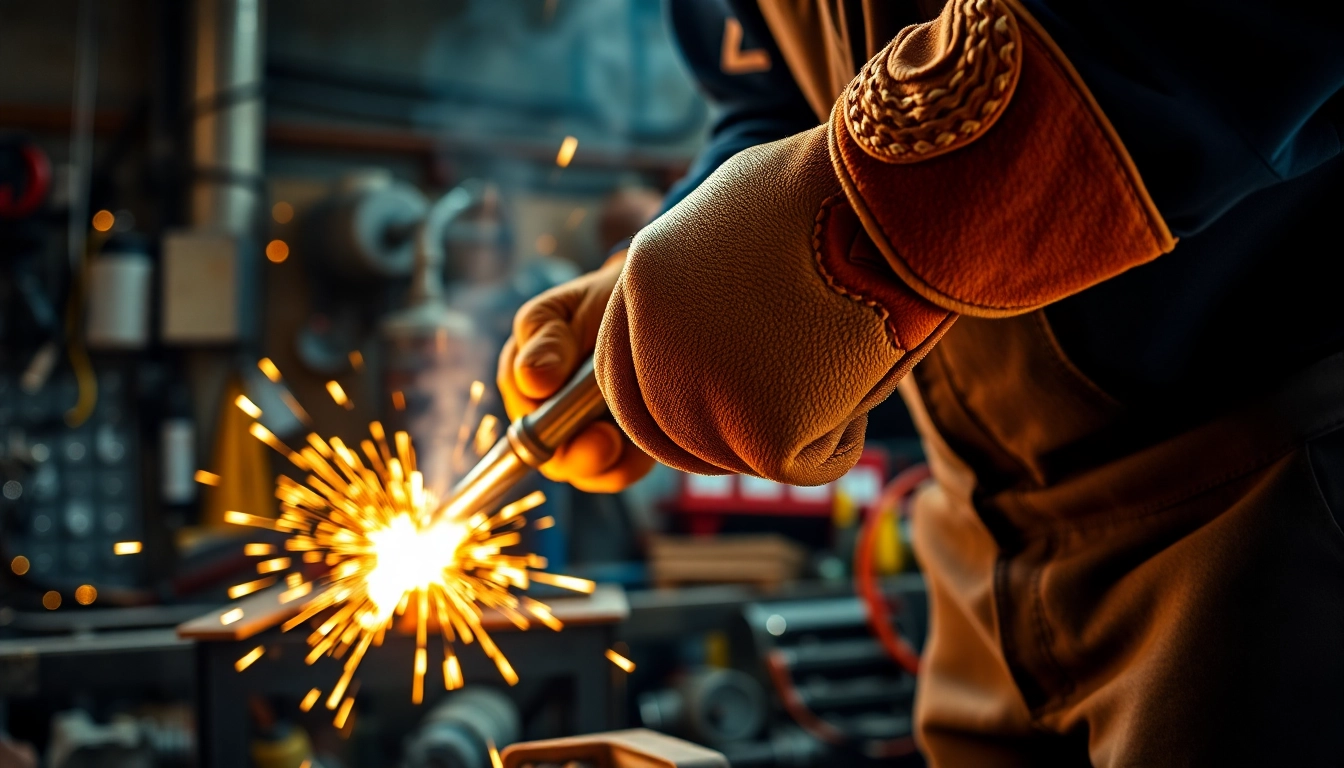Understanding Welding Gloves: Types and Materials
Welding gloves are a vital component in the personal protective equipment (PPE) arsenal of any welder. Their primary purpose is to protect the hands from extreme temperatures, sparks, and hazardous materials encountered during welding operations. However, to select the right pair, one must understand the various types and materials of welding gloves available. Whether you are an amateur or a seasoned professional, knowing the intricacies of welding gloves will guide you to make a beneficial choice that enhances both safety and performance.
The Importance of Material in Welding Gloves
The material of welding gloves significantly influences both protection and comfort. Most welding gloves are made from leather, and the type of leather used can impact the glove’s performance in various welding environments.
1. Cowhide: This is one of the most common materials for welding gloves due to its durability and resistance to heat and abrasion. It provides a good balance of flexibility and protection, making it suitable for most welding tasks.
2. Pigskin: Known for its softness and flexibility, pigskin gloves offer superior comfort and dexterity. They are particularly useful for TIG welding, where precise hand movements are essential.
3. Goatskin: These gloves are exceptionally soft and provide excellent dexterity. They are often used for detailed work, combining flexibility with good thermal protection.
4. Synthetic materials: Some gloves are made from synthetic leathers or blends that incorporate high-temperature resistant fibers. These materials may offer enhanced performance in very high-temperature settings but might not always deliver the same level of durability as leather.
Different Types of Welding Gloves Explained
In the world of welding, different processes require different gloves. Understanding the specific types can help you choose tailored protection for your needs.
1. MIG Welding Gloves: These gloves are designed to provide excellent dexterity and grip while protecting against molten metal. They typically feature a snug fit and flexible materials to allow for precise movements.
2. TIG Welding Gloves: Highly dexterous, these gloves are thin, allowing for maximum control. They are often made from softer leathers such as goatskin, which helps in maintaining feel while welding.
3. Stick Welding Gloves: These gloves are generally thicker, offering maximum protection against sparks and heat. They usually feature a gauntlet design to protect wrists from heat that can be generated during stick welding.
4. General Purpose Gloves: Designed for various welding tasks, these gloves typically balance durability, protection, and dexterity without specializing in a particular welding technique.
Selecting the Right Thickness for Your Needs
The thickness of welding gloves directly impacts protection and dexterity. Thicker gloves provide better heat resistance but may sacrifice movement and tactile feeling. Therefore, the selection of glove thickness should be aligned with the specific requirements of the welding task at hand.
1. Thin Gloves (less than 1.5 mm): Best suited for TIG welding where precision and dexterity are critical. They allow the welder to feel the electrode and metal better, which is essential for detailed work.
2. Medium Gloves (1.5-2.5 mm): These are versatile and can be used for MIG and stick welding. They strike a balance between protection and dexterity.
3. Heavy-duty Gloves (greater than 2.5 mm): Ideal for environments with high heat and sparks, these gloves offer maximum protection but limit dexterity. They are more suited for stick welding and heavy fabrication work.
Key Features to Look for in Welding Gloves
Choosing the right welding gloves involves considering several crucial features that ensure safety, comfort, and performance during welding operations.
Heat Resistance: What You Need to Know
Heat resistance is a paramount feature in welding gloves. When selecting gloves, consider the heat resistance rating, as well as any specific temperature conditions you will be working in. Look for gloves that can withstand temperatures exceeding 300°F to ensure proper protection against burn injuries.
Moreover, many gloves come with enhanced features like flame-retardant coatings or additional lining materials that increase heat resistance without sacrificing dexterity. Always verify manufacturer claims regarding heat resistance to ensure that they meet the needs of your specific welding activities.
Fit and Dexterity: Ensuring Comfort and Control
Fit and dexterity are critical for effective welding. A glove that is too tight can restrict movement, leading to fatigue, while a glove that is too loose may become a safety hazard. Opt for gloves that provide a snug fit around the fingers and palm without being constricting. Key features to look for include:
1. Grain and seam construction: Ensure the gloves have high-quality seams that don’t split under stress and that they feature reinforced stitching for added durability.
2. Adjustable closures: Many gloves come with adjustable cuffs that can be tightened to prevent debris from entering while allowing for a customizable fit.
3. Keystone thumb design: This ergonomic design allows for greater flexibility and natural hand position, which is particularly helpful in tasks requiring precise movements.
Safety Standards and Certifications for Welding Gloves
When purchasing welding gloves, ensure they meet industry safety standards and certifications. In the United States, look for gloves that conform to the American National Standards Institute (ANSI) standards for safety and protection.
1. ANSI/ISEA 105: This standard provides guidelines for assessing the performance of protective gloves, including cut, puncture, and heat resistance ratings.
2. EN standards: In Europe, many gloves will conform to the EN 12477 standard for protective gloves used in welding and similar processes, which assesses cut levels and heat resistance.
3. ISO standards: Various ISO certifications can also indicate the quality and safety standards met by manufacturing processes used.
Comparative Analysis of Popular Welding Glove Brands
With numerous brands available, choosing welding gloves can be overwhelming. Below, we will spotlight some reputable brands that have become favorites in the industry.
Top Picks for MIG Welding Gloves
1. Miller Electric: Known for a wide range of welding products, Miller’s MIG gloves are designed for both comfort and safety. The gloves feature a keystone thumb design offering great dexterity, making them suitable for long hours of welding.
2. Black Stallion: These gloves are manufactured with heat-resistant materials that provide excellent protection against sparks and abrasions. Their ergonomic fit ensures welders have a solid grip while allowing hand movement.
Best TIG Welding Gloves Reviewed
1. Caiman: Caiman gloves are well-regarded for their blend of flexibility and heat resistance. The goat leather material provides a comfortable feel and excellent grip.
2. Tillman: Their TIG welding gloves are made from soft grain leather, affording excellent dexterity while ensuring high resistance to heat and flame.
Value-for-Money Options in Welding Gloves
1. Harbor Freight: Offers budget-friendly options that do not compromise on quality, providing adequate protection while being accessible for DIY welders.
2. DeWalt: Known for durable work products, DeWalt gloves offer value in both performance and longevity, including flame-resistant materials at a reasonable price point.
Maintenance and Care Tips for Longevity of Welding Gloves
To ensure your welding gloves last, regular maintenance and proper care are essential. Not only does this increase their lifespan, but it also maintains their protective capabilities.
How to Clean Your Welding Gloves Properly
Cleaning methods depend on the glove material but generally include:
1. Leather Gloves: Wipe down with a damp cloth to remove dust and debris. Use a specialized leather cleaner for stubborn stains, and apply a conditioner to maintain suppleness.
2. Synthetic Gloves: Most synthetic gloves can be machine washed on a gentle cycle. Ensure you check the manufacturer’s label for specific care instructions.
Storage Tips to Maintain Glove Quality
When not in use, store welding gloves in a cool, dry place to prevent moisture damage and deterioration. Always flatten them out instead of balling them up to avoid creasing the leather and weakening its structure.
Using glove bags or a dedicated storage container can help protect them from external elements like dust and dirt that can lead to wear over time.
When to Replace Your Welding Gloves
Keeping track of wear and tear is crucial in deciding when to replace gloves. Signs that it’s time for a new pair include:
1. Visible Damage: Tears, holes, or significant wear on the fingertips or palm can significantly reduce protection.
2. Loss of Dexterity: If the gloves no longer provide the dexterity necessary for your welding tasks, it may be time for a new pair.
3. Unpleasant Odor: A persistent bad smell can indicate mildew or bacteria buildup, suggesting that the gloves are no longer suitable for safe use.
Frequently Asked Questions About Welding Gloves
As with any protective gear, questions often arise regarding the use of welding gloves. Below are some common queries along with concise answers.
Can You Use Regular Gloves for Welding?
While rubber or thick leather gloves may provide some protection against minor splatter and UV light, they lack the specialized features of welding gloves that ensure optimum protection against heat, flame, and sparks.
Are Welding Gloves Necessary for All Types of Welding?
Yes, regardless of the type of welding you are engaged in, wearing dedicated welding gloves is imperative. They ensure safety and maintain hand integrity against extreme temperatures and debris.
How Do I Know If My Welding Gloves Fit Properly?
The best way to ensure a proper fit is to try gloves on before purchasing. They should feel snug without being overly tight and allow for full range of motion without excess material that could snag during your work.


